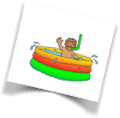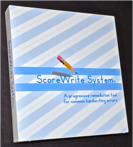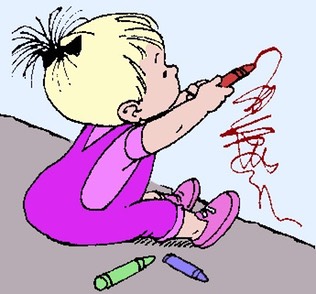CORONAVIRUS WRITING SAMPLE SERIES
The Coronavirus Writing Sample series is a promotional product meant to be used by therapists conducting TeleTherapy or distant learning with their students. These writing samples are printed on Primary paper, leaving room on the bottom of each page for students to copy the writing prompt printed on the top. Therapists have permission to email parents a copy of one or more of the four writing samples so they can download and print it in advance of the therapy session. Each writing sample has in its left margin the word and letter count as well as the number of capitals and punctuation marks. These numbers provide the basis for calculating a student’s percentage of accuracy for each of the handwriting skill areas scored.
HAND-WASHING HANDWRITING
Handwriting skill, as all fine motor coordination, depends upon tactile (touch) skills. Just remember how difficult it was to coordinate your speech after having your mouth numbed at the dentist.
Here’s a fun way to improve tactile skills during this time of Covid 19 quarantine. Next time your child washes their hands — something we all are told to do several times a day — have them suds up the back of each hand and then close their eyes. Use your finger tip to draw a simple shape and ask them to guess what you drew. If their hands were sudsy enough, the shape you drew should be visible when they open their eyes to see the answer. By challenging the child’s tactile discrimination daily you will improve their hand-coordination needed for handwriting.
You can use the same activity to work on proper top-to-bottom letter formation skills by soaping up your hands then having your child ‘write’ letters on the back of your hands. If they don’t start their letters in the correct spot (usually the top of the letter) then give them a “start here” dot.
 HOMEBOUND HANDWRITING LESSONS
HOMEBOUND HANDWRITING LESSONS
Practice makes permanent! Remember to practice perfectly so handwriting errors don't become habits. Keep the writing practices short and focus on the quality of penmanship - not quantity.
*SHOPPING LIST - Tape a lined shopping list on the refrigerator and tell your child to write down the groceries they want you to buy. Writing on a vertical surface will help improve their penmanship, and they will be more motivated to write neatly if you tell them you can only buy those items on the list you can easily read.
*SCHEDULE - During this time of social distancing and school closures, experts say it is important to keep kids on a schedule. Having your child help write the daily schedule is a great way not only to empower and engage your child, but to work on their handwriting. Use lined paper to provide the visual cue needed to practice neat writing. Remember to change the schedule daily.
*MOVEMENT BREAKS - Remember to schedule in moment breaks kids would naturally be getting at school with recess, PE, and walking between classes. Check out GoNoddle for some great moment breaks you can easily work into the schedule. UPPER BODY STRENGTH
One criteria for improving handwriting skills is upper body strength. Good penmanship requires not only a skilled pencil grip but the shoulder and neck strength to maintain eye-hand coordination during writing. Here are some fun activities to improve upper body strength:
*Michelangelo - Tape a page from a coloring book on the underside of a low table or chair and have your child lie on their backs while completing the coloring.
*Wall art - Begin with your child sitting in front of a smooth surface such as a wall or side of a cabinet. Give them a coloring worksheet to complete against the wall, requiring them to hold the paper with one hand while they color with the other hand.
* Wheelbarrow races - Holding your child by his knees or ankles have them ‘walk’ on their hands to carry stuffed animals from one side of the room to the other.
BACK TO SCHOOL
As an occupational therapist working in the school system don’t forget to document the level of your student’s handwriting skills at the beginning of the new school year. A writing sample collected in your ‘back to school’ therapy session will provide you both the data you will need for IEP goal reviews and progress reports as well as identify any adaptations (such as extended time, adaptive handwriting paper, or slant boards) the student may need in the classroom.
Here is a writing sample I used with each student on my caseload at the beginning of everyschool year. Not only did it demonstrate their writing skills but it allowed them to identify their goal for therapy.
SIMPLE SOLUTIONS Listening to a TED talk on“simplicity” this morning made me thinkabout some simple solutions to illegible handwriting in the school system.
PENCIL GRASP Writing against a vertical or semi-vertical surface encourages wrist extension , which in turn inhibits fisting and promotes the functional grasp pattern holding an object with an opposed thumb and the index and middle fingers. Using an empty thick binder turned sideways on the desk is a quick way to raise the writing surface to semi-vertical.
SPACING Crowding between words is a common complaint of illegibility. Research has shown that by skipping every other writing line not only spreads out a student’s writing vertically but also spreads out the spacing between words.
LETTER FORMATION By third and fourth grade, the typical classroom no longer has prominently posted letter formation samples. The assumption is that by third grade a student is no longer learning how to write but writing to demonstrate what they are learning. A letter formation strip or cue card taped to the desk is a simple solution for students struggling with legible letter formation.
The ScoreWrite System addresses the common handwriting errors of improper letter formation and poor spacing between words with the simple solution of adaptive handwriting paper and cue cards.

SUMMER TIPS FOR IMPROVING HANDWRITING
Summer time is a perfect time for embedding handwriting practice into functional daily tasks. You can help your kids improve their handwriting skills without them ‘working’ at it. Here is how:
SHOPPING LISTS Have your child write your shopping list! Use a lined shopping list — preferably one with a magnetic back that posts on your refrigerator and encourages writing on a vertical surface (good strategy for improving upper body strength and encouraging a functional pencil grasp). Work this into your daily routine where your child adds items to the list while you're washing dishes or preparing a meal.
CALENDARS and SCHEDULES Set up a family calendar for the summer — again preferably one posted on a wall to encourage that vertical writing surface. (There are many options available at your local office store.) Then have fun planning out your summer days. Whether it’s as simple as “grocery shopping” or as fun as “4th of July party”, writing these simple entries on the calendar can be a great teaching tool for sizing and spacing — especially when there are multiple events in one day such as “call Grandma”, “pack for camping”, and “trash out”.
POSTCARDS Most sight seeing and summer trips involve at least one stop at a local store. While there, be sure to pick up a postcard for each child. Once home, a short note handwritten on a postcard is a great way for your child to practice their writing and keep in touch with Grandma!
SCRAPBOOKS A scrapbook is a fun way for your kids to both remember their summer and practice their writing. It doesn’t need to be fancy. Start with a spiral bound lined notebook (let your child choose the cover). Using a digital camera or your smart phone let your child snap a couple of photos at each destination. Once back home, print up the photo and have your child write something for each photo. This can be a description of the location such as “the Grand Canyon” or a memory of theirs such as “I got to ride a donkey to the bottom”.
Just as the spelling short cuts that are acceptable on twitter and texting can lead to poor spelling habits on school work — so can handwriting shortcuts used in daily life skills. Provide lined paper for shopping lists and schedules, and add lines to calendars and post cards to encourage letter alignment, sizing, and formation. Because the amount of writing will be brief - expect accuracy and require correction for letter formation and spacing errors.
HANDWRITING INSTRUCTION vs REMEDIATION
As an occupational therapist working in the public school system I had my fair share of students with handwriting legibility deficits on my caseload. If lucky enough to get them young, in kindergarten or first grade, I had time to provide instruction using a handwriting curriculum such as Handwriting Without Tears. However, many students didn’t show up on my caseload until third grade or older, including those occasional high schoolers who had never had intervention for their illegible handwriting in the past. For the older general education students with illegible handwriting, I found a remediation approach more effective.

Using the ScoreWrite System of adaptive handwriting paper to address the common handwriting errors of improper letter formation and spacing between words, older students were able to improve their handwriting legibility while keeping up with their classwork. The limited time I had them in therapy each week was spent on addressing the underlying deficits that impeded their handwriting skills such as postural ocular weaknesses, poorly integrated primitive reflexes, and sensory integration dysfunction.
IEP TIPS
Want to simplify the writing of IEPs? Think of a treasure map. The treasure, or destination, is increased independence in the student’s educational skills. The journey begins from where a student is now, or his present level of performance. The more measured and relevant you write the present levels of performance, the easier it will be to write measurable goals and objectives. Mapping out the journey from start to treasure will provide you with the milestones needed to master the goal. Writing the IEP as a journey will help you communicate more effectively with IEP team members as you map out the steps needed to reach the goal.
ScoreWrite System offers great tools for measuring current handwriting performance and developing measurable handwriting goals and objectives. Its Letter Formation Scoring Aid, Color Code, and progressive writing samples make it easy to calculate a student’s legibility in percentage of letter formation and spacing errors. With present levels of performance in handwriting objectively documented, measurable goals can be written and progress easily tracked.
COLORING WALL
Want to promote a functional pencil grasp and the good penmanship habit of stabilizing the paper while writing? Try a coloring wall. Have your emerging writers hold up their coloring and dot-to-dot worksheets against a smooth vertical surface to complete. This requires the use of a stabilizing hand to hold the worksheet while coloring or drawing. Additionally it is a great way to improve upper body strength and stability. The vertical orientation of this activity activates wrist extension and promotes a tripod grasp.

PERFECTION
Practice does NOT make perfect. Practice makes permanent! So remember to practice perfectly so handwriting errors don't become habits. Check out this free handwriting worksheet maker - but remember keep it brief and monitor your student’s technique so they don’t practice imperfectly. https://www.handwritingworksheets.com/
